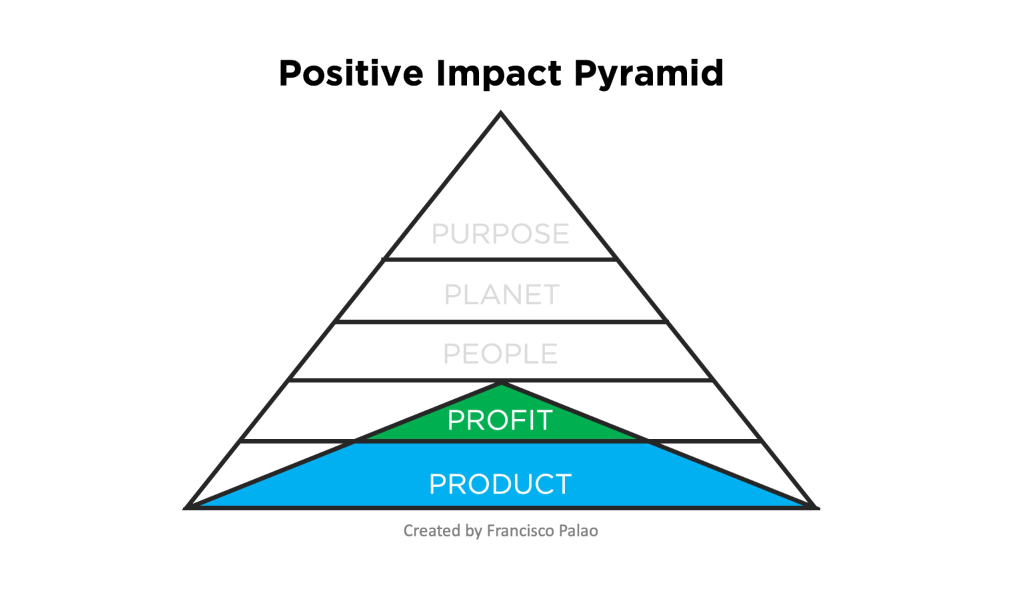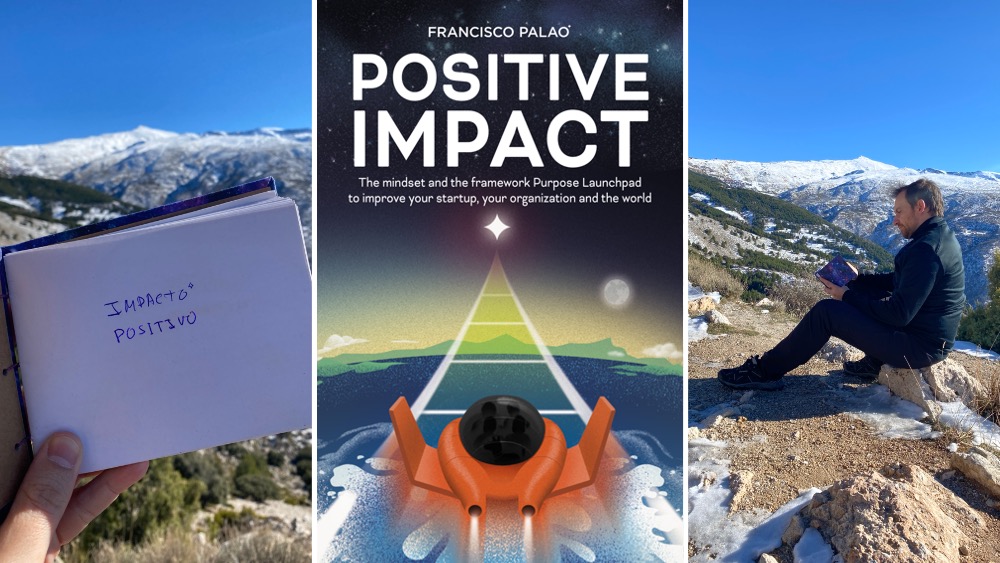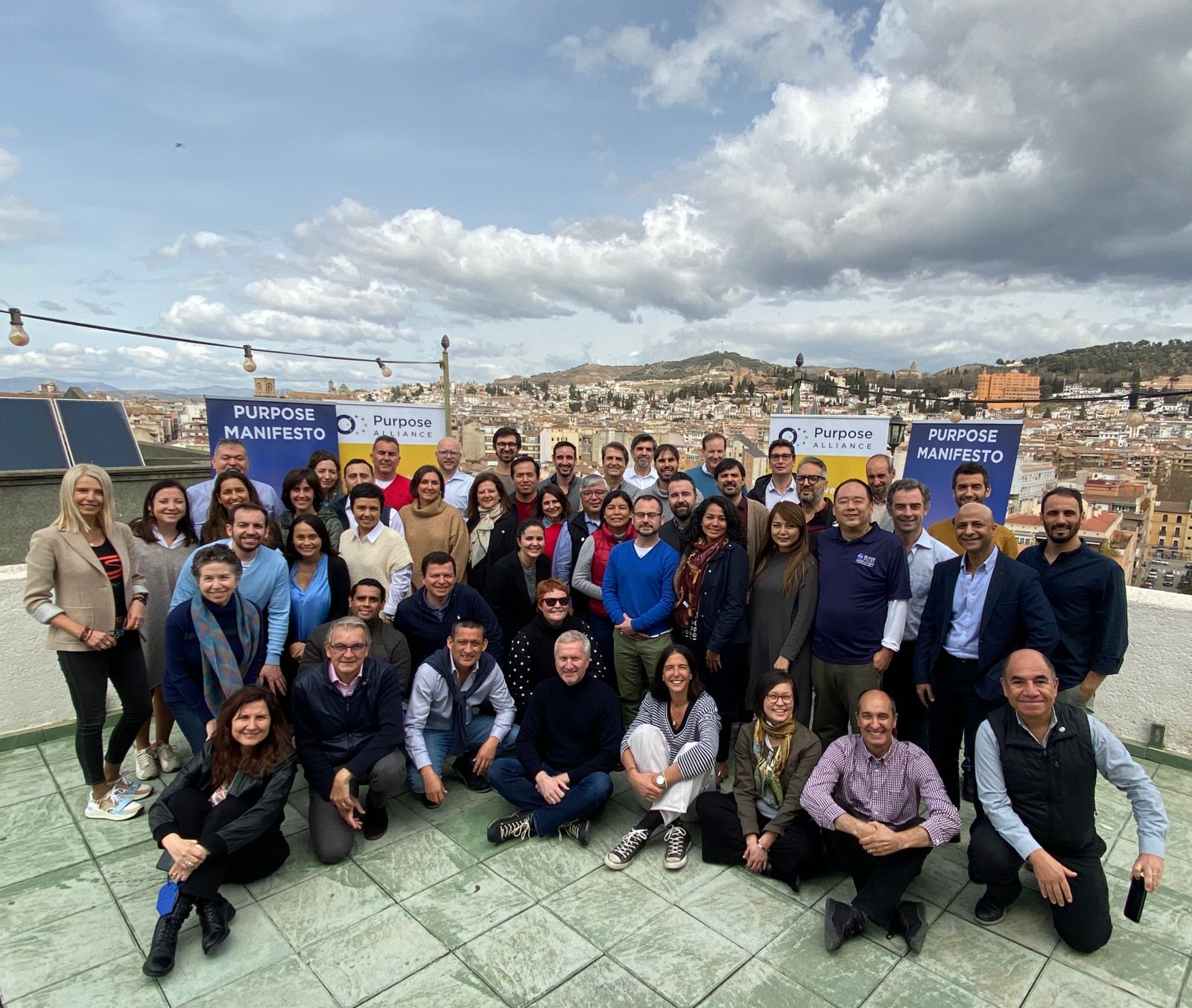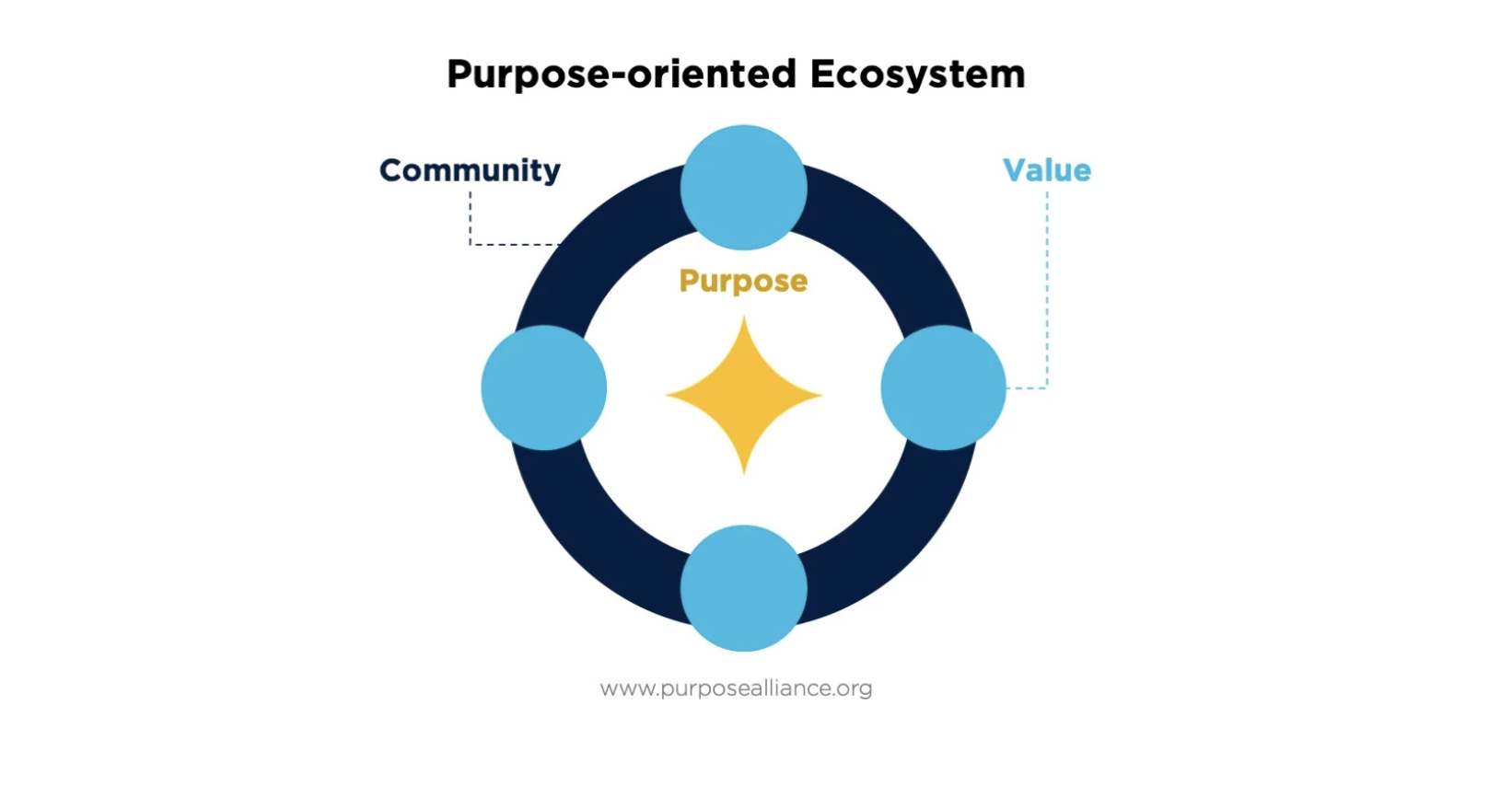ARTICLES | IMPACT RESOURCES
Innovation is not enough anymore: The Positive Impact Pyramid
October 26, 2022
Francisco Palao, Founder of Purpose Alliance and author of the book Positive Impact.
I clearly remember when, about twenty years ago, I would frequently hear the admonition “Marketing is no longer enough.” It was no longer enough to promote our products and position them properly in the market; it was also becoming crucial to improve our offer by providing our clients with distinctive value. Marketing continued to be important, but it was no longer the only thing we needed to do well; we had to take it one step further and innovate.
We are currently at the brink of a similar pivotal moment that is pushing innovation to the background. In this article, I will describe the reasons why innovation is no longer enough and explain the next step that we must take.
Today, we have access to more knowledge and more technologies than we could have even imagined not too long ago. We have access to all the information we could need—literally at our fingertips. Most of us have mobile phones with processing capabilities millions of times greater than the supercomputer aboard Apollo 11, the NASA spacecraft that carried the first man to the moon. More innovative products have been launched on the market over the past ten years than were created in the preceding hundred years. There is no doubt that technology and innovation have been the main engines boosting our society during the twenty-first century.
Humanity, however, is going through a paradoxical situation. Despite all the technology and innovation in the world, we continue to face all types of challenges: climate change, social inequality, armed conflict, and much more. Are we truly moving forward as a civilization?
To try to answer this question, it would be good to recall one of the lessons Margaret Mead, the famous anthropologist, taught us. One of her students once asked her the following question during a class: What was the first indication of human civilization? Any of us might have thought that it would be discovering a spoon, a bowl, or some type of “technology” from that time. However, Dr. Mead surprised everyone with her reply. According to her, the first sign of a civilized society was a naturally healed human femur.
Dr. Mead explained that a wounded animal in the wild would be doomed to die, for it could no longer hunt for food or protect itself from predators. Finding a naturally healed human femur would indicate, however, that the person who had fractured their leg had survived, due to having been helped by other individuals. She explained that “helping someone else through difficulty is where civilization starts.” In other words, the advancement of our civilization is not a matter of technology, but rather of mindset. We evolve as a civilized species when we change the way we see the world and act to improve it.
I clearly remember when, about twenty years ago, I would frequently hear the admonition “Marketing is no longer enough.” It was no longer enough to promote our products and position them properly in the market; it was also becoming crucial to improve our offer by providing our clients with distinctive value. Marketing continued to be important, but it was no longer the only thing we needed to do well; we had to take it one step further and innovate.
We are currently at the brink of a similar pivotal moment that is pushing innovation to the background. In this article, I will describe the reasons why innovation is no longer enough and explain the next step that we must take.
Today, we have access to more knowledge and more technologies than we could have even imagined not too long ago. We have access to all the information we could need—literally at our fingertips. Most of us have mobile phones with processing capabilities millions of times greater than the supercomputer aboard Apollo 11, the NASA spacecraft that carried the first man to the moon. More innovative products have been launched on the market over the past ten years than were created in the preceding hundred years. There is no doubt that technology and innovation have been the main engines boosting our society during the twenty-first century.
Humanity, however, is going through a paradoxical situation. Despite all the technology and innovation in the world, we continue to face all types of challenges: climate change, social inequality, armed conflict, and much more. Are we truly moving forward as a civilization?
To try to answer this question, it would be good to recall one of the lessons Margaret Mead, the famous anthropologist, taught us. One of her students once asked her the following question during a class: What was the first indication of human civilization? Any of us might have thought that it would be discovering a spoon, a bowl, or some type of “technology” from that time. However, Dr. Mead surprised everyone with her reply. According to her, the first sign of a civilized society was a naturally healed human femur.
Dr. Mead explained that a wounded animal in the wild would be doomed to die, for it could no longer hunt for food or protect itself from predators. Finding a naturally healed human femur would indicate, however, that the person who had fractured their leg had survived, due to having been helped by other individuals. She explained that “helping someone else through difficulty is where civilization starts.” In other words, the advancement of our civilization is not a matter of technology, but rather of mindset. We evolve as a civilized species when we change the way we see the world and act to improve it.
The challenges of humanity are the greatest opportunities
Going back to the challenges humanity faces, it’s important, then, to see things differently. I often like to quote Peter Diamandis in this regard, when he says that “The world’s biggest problems are the world’s biggest market opportunities.” So, not only is it possible to improve the world while improving our business, but the best way to boost our business is precisely by trying to create a better world.
Each day, more organizations define a purpose (in addition to their vision and their mission) to express how they want to positively contribute to the world. We are also seeing communities like BCorp or Purpose Alliance emerge in line with this trend, since it’s been proven that the positive impact generated by purpose-driven organizations is twofold: it impacts the world and their own business.
Google is one example. Its purpose is “to digitize and democratize access to information,” which over time has become a purpose-driven ecosystem that has created around itself a series of initiatives that attempt to solve the challenges separating reality from the organization’s purpose (just as I detailed in my post called “Industries Create Scarcity, Purpose Generates Abundance”). Tesla, whose purpose is to “accelerate the world’s transition towards a sustainable energy model,” is another example, and it has also become an ecosystem in which a series of products and services coexist, having reached a market capitalization greater than all of its competitors combined. How has Tesla achieved this in only a few years?
Going back to the challenges humanity faces, it’s important, then, to see things differently. I often like to quote Peter Diamandis in this regard, when he says that “The world’s biggest problems are the world’s biggest market opportunities.” So, not only is it possible to improve the world while improving our business, but the best way to boost our business is precisely by trying to create a better world.
Each day, more organizations define a purpose (in addition to their vision and their mission) to express how they want to positively contribute to the world. We are also seeing communities like BCorp or Purpose Alliance emerge in line with this trend, since it’s been proven that the positive impact generated by purpose-driven organizations is twofold: it impacts the world and their own business.
Google is one example. Its purpose is “to digitize and democratize access to information,” which over time has become a purpose-driven ecosystem that has created around itself a series of initiatives that attempt to solve the challenges separating reality from the organization’s purpose (just as I detailed in my post called “Industries Create Scarcity, Purpose Generates Abundance”). Tesla, whose purpose is to “accelerate the world’s transition towards a sustainable energy model,” is another example, and it has also become an ecosystem in which a series of products and services coexist, having reached a market capitalization greater than all of its competitors combined. How has Tesla achieved this in only a few years?
Positive Impact Pyramid

The basis of any organization is to have a good product that offers real value to its customers, for which it must innovate. But as I’ve explained earlier, this will not be enough to take that organization to its maximum potential, since there are still several levels above Product that must be achieved. As with Maslow’s Pyramid, we can only ascend to the next level if the previous ones have been reached. Therefore, once we have a good product, we will be able to generate benefits (Profit) that will allow us to be sustainable as an organization. However, not only must we be sustainable at an economic level, we all know that nowadays we must also be socially (People) and environmentally (Planet) sustainable; this triple sustainability is what will allow us to operate an organization today without consuming the resources of tomorrow. In fact, going back to all those challenges we face, it is no longer enough to be sustainable; the important thing is to improve the world in which we live. That last level, Purpose, is precisely what will guide our actions so as to generate a positive impact on the world, and at the same time, on our business.
In short, only those organizations that have a good Product will be able to generate Profit, which will allow them to be sustainable at a social (People) and environmental (Planet) level. And only those organizations that operate sustainably can claim to be purpose-driven, thus creating a Positive Impact on the world and on their own business.

The basis of any organization is to have a good product that offers real value to its customers, for which it must innovate. But as I’ve explained earlier, this will not be enough to take that organization to its maximum potential, since there are still several levels above Product that must be achieved. As with Maslow’s Pyramid, we can only ascend to the next level if the previous ones have been reached. Therefore, once we have a good product, we will be able to generate benefits (Profit) that will allow us to be sustainable as an organization. However, not only must we be sustainable at an economic level, we all know that nowadays we must also be socially (People) and environmentally (Planet) sustainable; this triple sustainability is what will allow us to operate an organization today without consuming the resources of tomorrow. In fact, going back to all those challenges we face, it is no longer enough to be sustainable; the important thing is to improve the world in which we live. That last level, Purpose, is precisely what will guide our actions so as to generate a positive impact on the world, and at the same time, on our business.
In short, only those organizations that have a good Product will be able to generate Profit, which will allow them to be sustainable at a social (People) and environmental (Planet) level. And only those organizations that operate sustainably can claim to be purpose-driven, thus creating a Positive Impact on the world and on their own business.
Doble Positive Impact
Why do we say that by creating a positive impact on the world, we also benefit our own business?
First of all, bear in mind that purpose-driven organizations are accessing a greater potential market as society becomes more and more aware of the global and local challenges we face. This growing awareness defines individuals’ consumption preferences. In other words, customers are increasingly consuming those brands that align with their own values and principles.
Secondly, in those previous examples, we can observe how organizations that reach the top of the Positive Impact Pyramid are the ones that create different products and services linked to their purpose, thus unlocking a number of opportunities that make them more relevant to the world, connecting with an abundance of opportunities and continuously expanding their business.
In fact, as seen in the image, organizations that only focus on obtaining economic benefits do not reach their full potential. These are precisely the organizations that continue to focus on innovating only to increase their profits. As explained above and visualized graphically in this diagram, this is no longer enough.
Organizations that are truly purpose-oriented can access an abundance of opportunities that multiply their impact and outcomes.
Purpose describes why an organization exists, offering a positive view of the world. Meanwhile, we can find a series of challenges that the organization and the world must face to make each purpose a reality, so each of these challenges can potentially become a new initiative, product, or service that will multiply the organization’s value to the world and to its bottom line; all in line with its own purpose. Each of these initiatives can be seen below, surrounding the Purpose.

The evolution from a traditional organization (which only innovates) to a more modern organization (which creates a positive impact) is obviously not simple. Among other challenges, we find that an organization that tries to evolve always encounters resistance from the immune system. In my next posts, I will continue talking about how to evolve an existing organization, and, of course, I describe it in greater detail in the book Positive Impact. Let me just say up front that the key to evolving an organization (or even to properly developing a startup) will not be implementing the latest technology or applying different innovation processes, but will be evolving the entire organization’s mindset. (The good news is that it can definitely be done.)
It’s up to you whether you look at the world through eyes focused entirely on generating profits and using innovation to improve your products and services or, conversely, whether you put on your impact glasses and use innovation to improve the world. It’s time to take our civilization to the next level. Now we have to create startups and evolve existing organizations that respond to those challenges facing humanity. Innovation is no longer enough; the time has come to go one step further.




![Grafica_ExOLaunchPad_Analisis-[Recuperado]24422](https://purposealliance.org/wp-content/uploads/2024/01/Grafica_ExOLaunchPad_Analisis-Recuperado24422.jpg)





